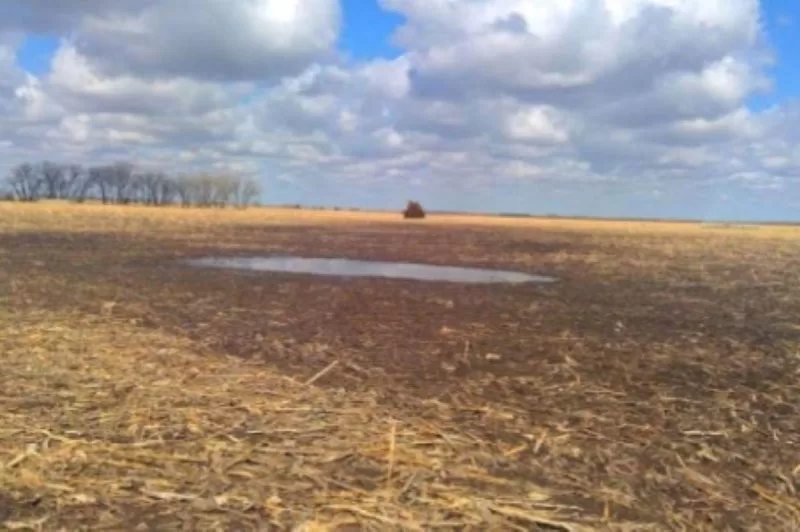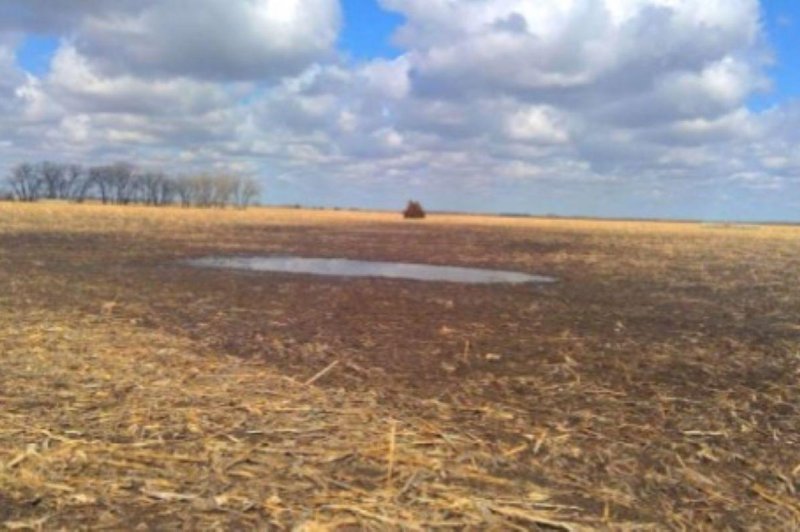1 of 2 | A disputed wetland on the South Dakota farm of Arlen Foster is shown in court documents as part of a case testing how much regulatory authority the Department of Agriculture has in the wake of this year’s Supreme Court ruling striking down the “Chevron deference doctrine.” Photo courtesy of the Pacific Legal Foundation
Nov. 5 (UPI) — A 13-year fight between a South Dakota farmer and the U.S, Department of Agriculture over a disputed wetland has emerged as one the first cases testing the power of regulatory agencies after a landmark Supreme Court ruling.
Arlen Foster, 73, of Miner County, S.D., says he has endured a “maddening” series of encounters, lawsuits and disputes with the USDA’s Natural Resources Conservation Service since 2011 over the fate of what he calls a “puddle” and the agency has labeled “a protected wetland.”
“It’s hard to truly understand the irrationality of the bureaucracy,” Foster told Farm Journal Magazine last week. “It would take me days to explain in detail how NRCS has repeatedly broken its own rules. It’s been a series of measures that defies belief for regular people.”
The case brought by Foster will get a new day in court in the wake of June’s Loper Bright Enterprises v. Raimondo decision, in which the high court overturned the “Chevron deference doctrine” under which judges have deferred to the expertise of agencies on how to interpret ambiguous language in laws pertaining to their responsibilities.
In August, after that ruling, the case of Foster v. U.S. Department of Agriculture was sent back to 8th Circuit Court of Appeals for a full hearing on his contention that the resources commission unfairly deemed the “puddle” to be a wetland and thus unavailable to be farmed under penalty of his losing eligibility for USDA benefits.
No hearing date has been set.
Not a ‘wetland’ but an ‘occasional pool’
Foster, who is the third-generation owner of his farm about 60 miles west of Sioux Falls, works with his daughter, son-in-law and six grandchildren to raise cattle, corn, soybeans and hay — except for some years on a field that contain a 0.8-acre spot that he describes as “an occasional pool.”
It was created not by nature, but as a result of a tree line planted by Foster’s father in 1936 to prevent erosion, he claims. Now, many years later with the trees having grown considerably, they collect deep snow drifts in the winter, and as the weather warms, the melting snow collects on the spot in the middle of the field.
Foster argues that the pool does not dry out fast enough to allow for the use of farm equipment in and around it in time to plant a crop — he would need to drain the pool to speed up its “drying out” to produce a crop there, but is unable to do so in wetter years.
The resources commission certified a wetland delineation for that portion of Foster’s farm in 2004. and four years later, he requested the agency review that certification under the so-called “Swampbuster” provisions of the 1985 Food Security Act.
Over the next few years, the agency twice rescinded its initial determination and restarted the review process from scratch, Foster claims.
In 2011, the commission decided to call the “puddle” a wetland, claiming that it is protected by federal law and setting the stage for the current ongoing legal battle. According to the suit, the regulators refused Foster’s request for new review in 2017, asserting he must provide new evidence for that to be granted.
That demand for new evidence, however, is “contrary to the statute,” and the deference shown to it by lower courts under the “Chevron doctrine” in subsequent rulings is an example of why that precedent needed to be struck down, Foster’s attorney said.
The Chevron doctrine meant lower courts automatically sided with the agency to deny Foster a chance to present his new evidence in a hearing, lawyer Jeffrey McCoy of the conservative-leaning, pro-business Pacific Legal Foundation told UPI.
“This matter will still go through the NRCS’ administrative process no matter what happens, but our legal question in this case is, ‘Did Congress give farmers the right to ask for a review any time they want?'” he said. “The statue says a certified wetland delineation is in effect until a farmer requests a new one.”
The government, meanwhile, argues that while Loper Bright “changes the mode of statutory interpretation,” it “does not change the result in this case because, setting all deference aside, the text, structure and history of the Swampbuster Act show that the NRCS’s reading of the Act remains the best one.”
In its own brief, the agency also disputed Foster’s interpretation that the law “confers a right on individual farmers to unilaterally void prior certifications by asking the NRCS to reconsider them,” calling that reading “unsupported” by the law’s history.
Wide-ranging consequences
In the larger picture, the Loper Bright decision could have wide-ranging consequences for USDA regulations, experts say, including recent rules to strengthen the Packers and Stockyards Act, which the Biden administration called necessary for “fairer, more competitive and more resilient meat and poultry supply chain” and to lower food prices.
The new rule “provides clearer tests and frameworks around unfair practices that harm market participants individually and unfair practices that harm markets overall,” the USDA said in June while announcing the provisions.
There also are other possible consequences for agriculture.
“Crop insurance regulations will be revisited,” attorney Brianna Schroeder, of Indianapolis-based Janzen Schroeder Agricultural Law, predicted in a July blog post. “Wetland determinations and recent [clean water] rules will be in the crosshairs. Pesticide regulations and the [Environmental Protection Agency’s] new regulation setting limits on PFAS in water could also be challenged.”
Judicial review of administrative decisions “is going to look wildly different from here on out as we rely on courts — not agencies — to decide what statutory language means,” she wrote, adding that most farm groups, including the American Farm Bureau, applauded the decision as a step toward taking the “arbitrariness” of regulatory decisions away from agencies whose priorities tend to change depending who is in the White House.
Opponents, however, have said the ruling is a “recipe for chaos,” taking the power of regulation away from experts and handing it to an unelected federal judiciary.
“In one fell swoop, the majority today gives itself exclusive power over every open issue — no matter how expertise-driven or policy-laden — involving the meaning of regulatory law,” wrote Justice Elena Kagan in her dissent from the ruling. “As if it did not have enough on its plate, the majority turns itself into the country’s administrative czar.”
McCoy maintains that in the post-Loper Bright world, there will still be plenty of opportunity for agency experts to weigh in on legal interpretations of policy, but they will have to come as expert witnesses in court cases and during the drafting of amendments by Congress.
“Congress will have to play a bigger role in interpreting or clarifying what regulations are,” he said. “Prior to Loper Bright, what you would see is agencies often interpreting a statute one way, and if the administration changes, sometimes the statute would be interpreted in a completely opposite way.
“The agencies will still write recommendations for what should be part of the statute,” he added. “I think experts and expert agencies will still play a meaningful role, and within Loper Bright, there is a way for Congress delegate discretion to the agencies as well.”
Two decades of fighting
UPI attempted to contact Foster for comment, but did not get a response by deadline.
However, in his comments to Farm Journal, the grower said his struggles, which first began in 2004, have seemed never-ending.
“It’s hard to believe this has dragged out for two decades,” he said. “They stretch you out over time and never give you a determination, just waiting for you to run out of money or will power,” praising the Pacific Legal Foundation for representing him at no charge.
About the upcoming hearing before the 8th Circuit, Foster added, “We’re finally getting a chance to present the facts to a court that will listen. My job now is to keep going for the sake of other landowners and the truth.”

